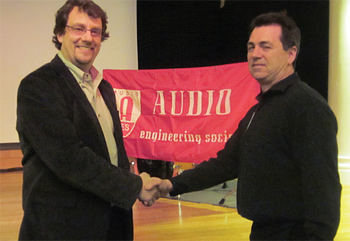Beware the Specs

At this time of year when many of us head to NAB to gather information about audio products for our projects, we inevitably collect specification sheets and product literature to help us decide which to choose.
But how meaningful are these specs? How well do they reflect the real performance and sound of audio products? Do they provide the information we need to differentiate performance among competing models?
CRITICAL THINKING
In the 1970s Richard C. Heyser, a researcher at the Jet Propulsion Laboratory, and a senior editor and loudspeaker reviewer for Audio magazine, realized that typical frequency response and distortion measurements didn't give a good indication of how a loudspeaker would sound, or provide insight as to why two different models that measured the same would sound totally different.

Jonathan Novick (L) and James Williamson, chairman of the AES NY Section, at a meeting of the New York section of the Audio Engineering Society in March. His idea was that we just weren't measuring the right things and his questioning led to the invention of TDS (time delay spectrometry), methods of measurement in both the time and frequency domains. These new measurements did indeed start to give us ideas of the kinds of measurements that could relate to what we hear and pointed the way to further investigations.
Yet over 40 years later, for the most part, we still primarily rely on frequency domain measurements, like frequency response and THD+N (total harmonic distortion plus noise) to describe audio products, especially electronics. (TDS measurements are still used today, but mostly for acoustics and loudspeaker measurements.)
Given that this is the situation we're dealing with right now, it's a good idea to know how to critically read specs, to note what details manufacturers provide us, and perhaps more importantly, what they leave out.
SPECIFICATIONS
A couple of examples were given by Jonathan Novick, director of sales at Audio Precision, in a timely presentation at a meeting of the New York section of the Audio Engineering Society in March. To illustrate his points, Novick looked at audio power amplifiers and power output and distortion specifications.
There are different ways to arrive at the power output of an amplifier, Novick said. There's one developed by U.S. Federal Trade Commission (FTC). Another common standard is that from the EIA (Electronic Industries Alliance), and there are those from international standards bodies like JEITA (Japan Electronics and Information Technology Industries) or DIN (the German Institute for Specification), that could show up on spec sheets as well. But from what I've observed in a quick survey of power amp spec sheets, the method of measuring power output isn't often listed.
The FTC method is the most stringent way of measuring power output, as it demands pre-conditioning of the amp before measurements are taken, that all channels are driven under load during the test, and that power is given for a specified total harmonic distortion reading, and that the reading has to be valid for a quarter of a watt to full rated output.
Novick said that the FTC test more closely correlates with how we set a power amp for normal listening, which is generally not at full power. While better reflecting reality, this method tends to give a lower power output number compared to other methods.
Then there's distortion. The THD+N number by itself doesn't indicate what kinds of distortion are present, and how objectionable they would be. Novick demonstrated this by playing a portion of a popular song through three different distortion-causing circuits—clipping, crossover and slew rate.
Clipping distortion was perceived as being less objectionable than crossover distortion, for example. Novick noted that the FTC test, if done correctly, would highlight crossover distortion, but his observation was that few do it correctly.
KEEP IN MIND
There are a few other things to watch for when reading and comparing specifications.
Are power ratings given across a frequency band or for a single frequency only, like 1 kHz (as is done too often)?
Was a weighting filter used for measurements? This can lead to some misleading specs. A weighting filter suppresses harmonics in the measurement result, which makes it appear there is less total harmonic distortion than there really is. A high pass filter in the measurements may hide power supply ripples at 60 Hz or its harmonics.
Do the specifications actually match the capabilities of the product? In the case of a power amp, a power output in bridged mono mode gives a high wattage output number that marketing would love to promote, but it's meaningless if the amp cannot really be operated in this mode.
Also, check at what impedance the power output ratings are given. The lower the impedance, the higher the number, but the amp can actually operate at those lower impedances.
It should be obvious that for specifications, single numbers don't come close to giving a full picture of the performance of audio gear. Novick suggested that graphs should be included in spec sheets. I would concur, by adding that graphs should have meaningful scales that don't compress the variations in the data.
Novick summed up the audio specs and measurement situation by saying "traditional testing is only the starting point. There's work to be done to create new tests."
Anyone game?
Mary C. Gruszka is a systems design engineer, project manager, consultant and writer based in the New York metro area. She can be reached via TV Technology.
The professional video industry's #1 source for news, trends and product and tech information. Sign up below.
